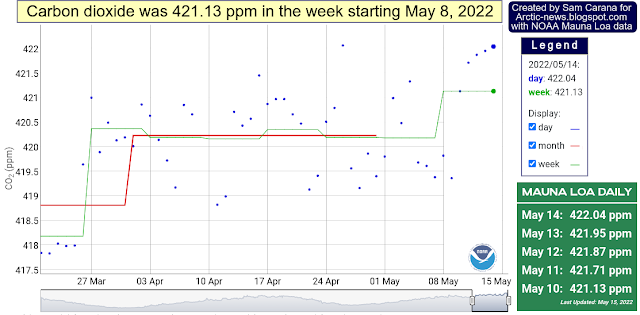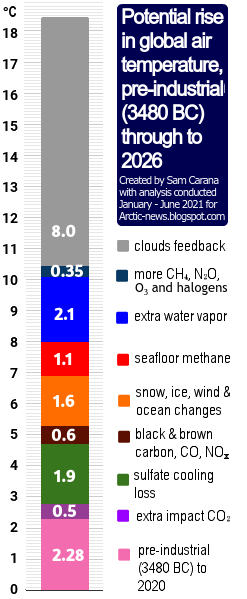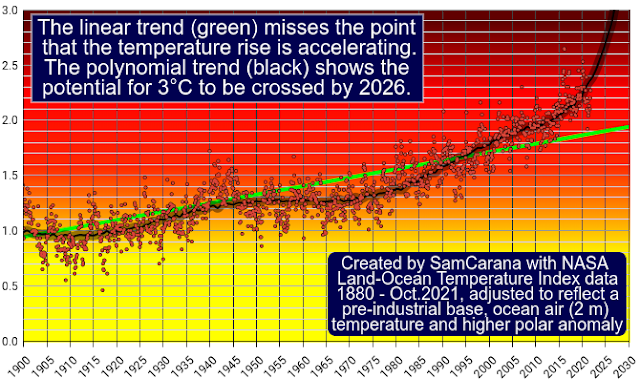The concentration of carbon dioxide (CO₂) in the atmosphere recently broke two records at Mauna Loa, Hawaii, CO₂ was 421.63 in the week starting May 29, 2022, while CO₂ was 420.99 ppm in May 2022.
Earlier, very high daily and hourly measurements were recorded at Mauna Loa, as illustrated by the image below, showing one hourly measurement of 424 ppm (on May 28, 2022), as well as sequences of daily measurements in the green insets.
The image below shows carbon dioxide concentration rising over the past few years, with surface flask measurements well above 422 ppm at Mauna Loa recently.
Carbon dioxide concentration is even higher over the Arctic. The image below shows carbon dioxide approaching 430 ppm at Barrow, Alaska.
To get an idea how much greenhouse gases have risen, a 2021 study points at concentrations of 190 ppm for CO₂, 370-375 ppb for CH₄ and 200-245 ppb for N₂O some 18 ka to 21 ka. By comparison, the MetOp image below shows a global mean methane level of 1951 ppb, which is more than five times as high, while the image also shows a peak of 2405 ppb, at 293 mb on June 7, 2022 pm.
The MetOp image below shows a lot of methane over the Arctic on May 30, 2022 pm, at 742 mb, which is much closer to sea level.
The trigger for such a huge rise could be a cataclysmic alignment of the upcoming El Niño with a high number of sunspots, which look set to reach maximum impact around July 2025.
We are currently in the depths of a persistent La Niña, as illustrated by the image on the right, adapted from NOAA. This suppresses the temperature rise.
El Niños typically occur every 3 to 5 years, according to NOAA and as also illustrated by the NOAA image below, so the upcoming El Niño can be expected to occur soon.
A huge temperature rise looks set to unfold soon, first of all in the Arctic, triggered by the combined impact of an upcoming El Niño and a peak in sunspots.
Sunspots are currently well above what NOAA predicted, as illustrated by the image on the right, adapted from NOAA.
The next El Niño looks set to line up with a high peak in sunspots, in a cataclysmic alignment that could push up the temperature enough to cause dramatic sea ice loss in the Arctic, resulting in runaway temperature rise by 2026.
A huge temperature rise in the Arctic
There are many further indications that we're on the brink of a huge temperature rise in the Arctic.
 |
| [ see also more background at the Extinction page ] |
This would in turn also cause more water vapor to enter the atmosphere, further speeding up the temperature rise, especially in the Arctic, where vast amounts of methane are contained in sediments at the seafloor and where there is very little hydroxyl in the air to break down the methane.
Temperatures look set to rise further in the Arctic, due to falling away of sulfate aerosols, as illustrated by the IPCC image below that shows how much temperatures are currently suppressed in the Arctic due to aerosols and thus also shows how much temperatures in the Arctic look set to rise as the aerosol masking effect falls away.
Conversely, there could be a temperature rise due to releases of other aerosols that have a net warming impact, such as black and brown carbon, which can increase dramatically as more wood burning, forest fires and urban fires take place, which again would hit the Arctic hard by darkening the surface as they settle on the snow and ice cover, thus speeding up its decline.
Furthermore, the combined impact of aerosols and nitrogen fertilizers has been underestimated; a recent study concludes that when ammonia, nitric acid and sulfuric acid are present together, they contribute strongly to the formation of cirrus clouds.
 |
| [ from earlier post ] |
 |
| [ from earlier post ] |
What would happen if just methane kept rising, i.e. without change in other forcers? The image below shows methane with a trend added that points at a rise that could represent a forcing of 780 ppm CO₂e in 2028, which means that the clouds tipping point at 1200 ppm CO₂e would be crossed by methane and carbon dioxide alone (assuming no change in other forcers and with carbon dioxide remaining at 421 ppm), which would cause an additional 8°C rise in temperature.
In conclusion, temperatures could rise strongly soon, driving humans extinct as early as in 2025, while temperatures could skyrocket in 2026, making it in many respects rather futile to speculate about what will happen beyond 2026. At the same time, the right thing to do now is to help avoid the worst things from happening, through comprehensive and effective action as described in the Climate Plan.
In the video below, Jennifer Hynes and Sandy Schoelles discuss the situation.
Links
• NOAA - Global Monitoring Laboratory, Recent Daily Average CO₂ at Mauna Loa, Hawaii, U.S.
https://gml.noaa.gov/ccgg/trends
• NOAA - Global Monitoring Laboratory, at Barrow, Alaska, U.S.
https://gml.noaa.gov/dv/iadv/graph.php?code=BRW&program=ccgg&type=ts
• Globally resolved surface temperatures since the Last Glacial Maximum - by Matthew Osman et al. (2021)
https://www.nature.com/articles/s41586-021-03984-4
• Arctic Hit By Ten Tipping Points
https://arctic-news.blogspot.com/2020/04/arctic-hit-by-ten-tipping-points.html
• NOAA - ENSO: Recent Evolution, Current Status and Predictions
https://www.cpc.ncep.noaa.gov/products/analysis_monitoring/lanina/enso_evolution-status-fcsts-web.pdf
• NOAA - El Niño
https://www.noaa.gov/education/resource-collections/weather-atmosphere/el-nino#:~:text=An%20El%20Ni%C3%B1o%20condition%20occurs,every%203%20to%205%20years.
• NOAA - Monthly Temperature Anomalies Versus El Niño
https://www.ncei.noaa.gov/access/monitoring/monthly-report/global/202204/supplemental/page-4
• MetOp satellite
https://www.ospo.noaa.gov/Products/atmosphere/soundings/iasi
• NOAA 20 satellite
https://www.ospo.noaa.gov/Products/atmosphere/soundings/nucaps/NUCAPS_composite.html
• Ten temperature rise indications
• Sunspots
https://arctic-news.blogspot.com/p/sunspots.html
• NOAA - sunspots
https://www.swpc.noaa.gov/products/solar-cycle-progression
• Latent heat
https://arctic-news.blogspot.com/p/latent-heat.html
• Blue Ocean Event
https://arctic-news.blogspot.com/p/blue-ocean-event.html
• Feedbacks
https://arctic-news.blogspot.com/p/feedbacks.html
• Aerosols
https://arctic-news.blogspot.com/p/aerosols.html
• Discovery uncovers need for ammonia emission regulations
• How ice clouds develop – Asian monsoon influences large parts of the Northern Hemisphere https://aktuelles.uni-frankfurt.de/.../how-ice-clouds...
• Synergistic HNO3 H2SO4 NH3 upper tropospheric particle formation - by Mingyi Wang et al. https://www.nature.com/articles/s41586-022-04605-4
• Clouds feedback and tipping point
https://arctic-news.blogspot.com/p/clouds-feedback.html
• Jet Stream
https://arctic-news.blogspot.com/p/jet-stream.html
• The Importance of Methane
https://arctic-news.blogspot.com/p/the-importance-of-methane-in-climate.html
• Runaway temperature rise by 2026?
• Co-extinctions annihilate planetary life during extreme environmental change - by Giovanni Strona and Corey Bradshaw (2018)
• When Will We Die?
https://arctic-news.blogspot.com/2019/06/when-will-we-die.html
• NOAA annual mean global methane data (downloaded June 10, 2022)
https://gml.noaa.gov/webdata/ccgg/trends/ch4/ch4_annmean_gl.txt
• Climate Plan
https://arctic-news.blogspot.com/p/climateplan.html




























































